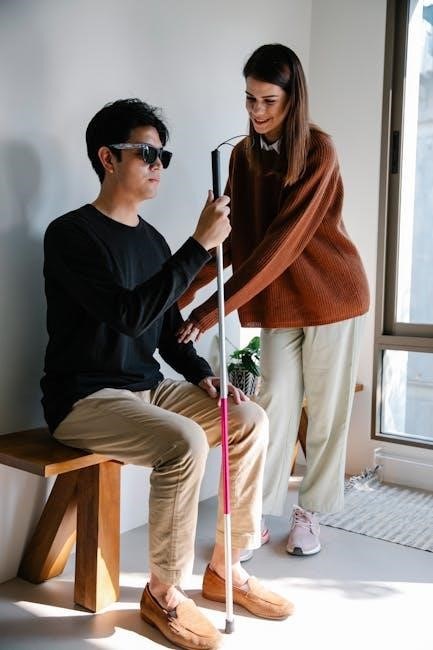Radiographic positioning is a crucial role in medical imaging‚ ensuring accurate diagnoses. It involves precise alignment of body parts to capture clear images‚ enhancing patient safety and diagnostic accuracy.
1.1 Definition and Purpose
Radiographic positioning refers to the precise alignment of a patient’s body part under X-ray to capture accurate images. Its purpose is to ensure diagnostic-quality images‚ enhancing patient safety and aiding in precise medical evaluations. Proper positioning minimizes radiation exposure and ensures clarity‚ making it vital for effective treatment planning. The technologist must understand anatomy and equipment to achieve optimal results‚ ensuring images meet diagnostic standards while maintaining patient comfort and safety throughout the procedure.
1.2 Importance in Diagnostic Imaging
Accurate radiographic positioning is essential for producing high-quality images that aid in precise diagnoses. Proper alignment ensures that anatomical structures are clearly visible‚ reducing the need for repeat scans and minimizing radiation exposure. This clarity allows healthcare providers to identify abnormalities‚ fractures‚ or diseases early‚ leading to timely and effective treatment. Well-positioned images also reduce diagnostic errors‚ enhancing patient outcomes and streamlining the decision-making process for medical professionals.

Key Principles of Radiographic Positioning
Key principles include proper patient preparation‚ accurate alignment‚ and use of radiographic markers. These ensure clear‚ diagnostic-quality images while minimizing radiation exposure and enhancing patient safety.
2.1 Patient Preparation and Safety
Patient preparation involves removing jewelry‚ ensuring proper hygiene‚ and using protective gear like lead aprons. Safety includes monitoring radiation exposure and ensuring patient comfort. Proper positioning minimizes discomfort and ensures diagnostic-quality images. Clear communication and assessing patient mobility are crucial. Ensuring the patient understands the procedure reduces anxiety and improves cooperation. Safety protocols align with radiation protection principles‚ prioritizing minimal exposure while achieving accurate results.
2.2 Proper Alignment and Anatomy
Proper alignment ensures accurate radiographic images by positioning the patient correctly relative to the X-ray beam. Understanding anatomy is crucial to align body parts accurately. Misalignment can distort images‚ leading to diagnostic errors. Key anatomical landmarks guide positioning‚ ensuring structures are centered and symmetrical. Proper alignment minimizes overlap of bones‚ providing clear views of joint spaces and soft tissues. This ensures diagnostic accuracy and avoids retakes‚ optimizing patient safety and image quality.
2.3 Use of Radiographic Markers
Radiographic markers are essential for identifying patient orientation and anatomy in images. They help distinguish right from left and ensure proper alignment. Markers should be placed discretely to avoid obscuring diagnostic areas. Correct use improves image interpretation and reduces errors. Common markers include lead letters or digital indicators. Proper placement ensures clarity‚ aiding in accurate diagnosis and maintaining patient safety. Incorrect marker placement can lead to misinterpretation‚ emphasizing the need for precision.

Radiographic Positioning for Upper Limb
This section covers positioning techniques for the shoulder‚ humerus‚ elbow‚ forearm‚ wrist‚ and hand. It includes AP‚ lateral‚ and oblique projections to ensure accurate imaging of upper limb anatomy.
3.1 Shoulder (AP and Lateral Projections)
For shoulder radiography‚ the patient stands upright or sits with the affected side against the image receptor. The AP projection aligns the central ray perpendicular to the midpoint of the shoulder‚ ensuring the humerus and glenoid cavity are centered. The lateral projection involves positioning the patient sideways‚ with the affected shoulder closest to the receptor. The central ray is angled to visualize the glenohumeral joint and surrounding structures clearly‚ ensuring proper alignment and minimal distortion for accurate diagnosis.
3.2 Humerus (AP and Lateral Views)
For the humerus‚ the patient is positioned upright or seated with the arm extended and palm facing backward. The AP projection aligns the central ray perpendicular to the humerus‚ ensuring the entire bone is visible. The lateral view requires the patient to flex the elbow‚ placing the humerus parallel to the receptor. Proper alignment ensures both proximal and distal ends are captured‚ providing clear visualization of fractures‚ dislocations‚ or abnormalities in the humeral shaft and surrounding anatomy.
3.3 Elbow (AP‚ Lateral‚ and Oblique Projections)
For elbow imaging‚ the patient is seated with the arm extended and palm facing down. The AP projection involves flexing the elbow slightly‚ aligning the central ray perpendicular to the elbow joint. The lateral view requires the elbow to be flexed at 90 degrees‚ ensuring the humerus and radius align. Oblique projections involve rotating the arm 45 degrees to better visualize the radial head or coronoid process. These views aid in diagnosing fractures‚ dislocations‚ or joint abnormalities‚ ensuring accurate assessment of the elbow anatomy.
3.4 Forearm (AP and Lateral Views)
For forearm imaging‚ the patient is seated or standing with the arm extended. The AP view requires the forearm to be supinated‚ with the central ray perpendicular to the mid-forearm. The lateral view involves flexing the elbow to 90 degrees‚ keeping the forearm parallel to the image receptor. These projections provide clear visualization of the radius and ulna‚ aiding in the diagnosis of fractures‚ deformities‚ or alignment issues. Proper positioning ensures optimal detail for accurate radiographic assessment.
3.5 Wrist (PA‚ Lateral‚ and Oblique Projections)
For the wrist‚ the PA view is obtained with the patient standing or sitting‚ arm extended‚ and wrist in neutral position. The lateral view requires the wrist to be flexed at 90 degrees‚ aligning the radius and ulna. Oblique projections involve rotating the wrist 45 degrees internally or externally to visualize the scaphoid and other carpal bones. Proper alignment ensures clear visualization of fractures‚ joint spaces‚ and bone alignment‚ aiding in accurate diagnosis of wrist injuries or conditions.

Radiographic Positioning for Lower Limb
This section covers proper techniques for imaging the pelvis‚ femur‚ knee‚ tibia/fibula‚ and ankle. It emphasizes correct patient positioning and alignment for optimal AP‚ lateral‚ and oblique projections.
4.1 Pelvis (AP Projection)
Imaging the pelvis in the anteroposterior (AP) projection requires the patient to stand upright with feet shoulder-width apart. The central ray is centered at the midsagittal plane‚ midway between the anterior superior iliac spines (ASIS) and the pubic symphysis. The pelvis should be fully included‚ with the iliac crests and proximal femurs visible. Proper alignment ensures accurate assessment of pelvic structures‚ including the acetabulum and sacrum. Adjustments may be made for patient mobility or anatomical variations to ensure a diagnostic-quality image.
4.2 Femur (AP and Lateral Views)
For the femur‚ the anteroposterior (AP) projection is taken with the patient standing upright‚ feet shoulder-width apart. The central ray is centered at the midsagittal plane‚ midway between the femoral heads. The entire femur‚ including the proximal and distal ends‚ should be visible. For the lateral view‚ the patient lies on the unaffected side with the affected leg flexed at the knee. Proper alignment ensures accurate assessment of femoral fractures or deformities‚ with adjustments made for patient mobility or equipment limitations.
4.3 Knee (AP‚ Lateral‚ and Oblique Projections)
For the knee‚ the anteroposterior (AP) projection is taken with the patient standing or sitting‚ knees extended. The central ray is centered at the midsagittal plane‚ perpendicular to the knee joint. The lateral view requires the knee to be flexed at 90 degrees‚ with the central ray aligned to the medial condyle. Oblique projections are obtained by rotating the leg 45 degrees medially or laterally to assess joint space and surrounding structures‚ ensuring proper alignment for diagnostic clarity and accuracy.
4.4 Tibia and Fibula (AP and Lateral Views)
The anteroposterior (AP) projection of the tibia and fibula is taken with the patient standing or seated‚ legs extended. The central ray is centered at the midsagittal plane‚ ensuring the tibia and fibula are parallel and fully visible. The lateral view requires the patient to lie on their side with the leg extended‚ and the central ray is perpendicular to the tibia. Both views provide clear visualization of bone alignment‚ joint spaces‚ and cortical integrity for accurate diagnosis.
4.5 Ankle (AP‚ Lateral‚ and Oblique Projections)
The anteroposterior (AP) ankle projection is taken with the patient weight-bearing‚ toes slightly dorsiflexed. The central ray is centered at the malleoli‚ ensuring the tibia‚ fibula‚ and talus are visible. The lateral view requires the patient to lie on their side with the ankle flexed at 90 degrees‚ providing a clear view of joint alignment. Oblique projections involve rotating the ankle 30-40 degrees to assess the cuboid and navicular bones‚ aiding in fracture or dislocation diagnosis.

Radiographic Positioning for Spine
Spine radiography involves specific techniques for cervical‚ thoracic‚ and lumbar regions‚ utilizing AP‚ lateral‚ and oblique views to assess alignment‚ fractures‚ and degenerative conditions accurately.
5.1 Cervical Spine (AP‚ Lateral‚ and Oblique Views)
The cervical spine is imaged using AP‚ lateral‚ and oblique views to evaluate fractures‚ degenerative changes‚ and spinal alignment. For the AP view‚ the patient stands upright with the head in a neutral position‚ ensuring the beam is angled to visualize C1-C7 vertebrae. The lateral view‚ taken with the patient supine or upright‚ aligns the cervical spine with the image receptor. Oblique views‚ taken at a 45-degree angle‚ highlight facet joints and neural foramina‚ aiding in diagnosing spondylosis or herniated discs.
5.2 Thoracic Spine (AP and Lateral Projections)
The thoracic spine is typically imaged using AP and lateral projections to assess fractures‚ degenerative changes‚ and spinal alignment. In the AP view‚ the patient stands upright‚ and the X-ray beam is angled to visualize T1-T12 vertebrae‚ ensuring the clavicles are moved downward. The lateral view is taken with the patient standing or sitting‚ aligning the spine with the image receptor. This projection helps evaluate vertebral body heights and the posterior elements‚ aiding in the diagnosis of conditions like kyphosis or vertebral fractures.
5.3 Lumbar Spine (AP‚ Lateral‚ and Oblique Views)
The lumbar spine is imaged using AP‚ lateral‚ and oblique views to evaluate degenerative changes‚ fractures‚ and alignment. The AP view captures the vertebral bodies and intervertebral spaces‚ with the patient standing upright. The lateral view assesses lordosis and disc height‚ taken with the patient standing or sitting. Oblique views‚ taken at 45-degree angles‚ highlight facet joints and soft tissues‚ aiding in diagnosing conditions like spondylolysis or spondylolisthesis. Proper patient positioning ensures accurate visualization of the lumbar region.

Radiographic Positioning for Chest and Thorax
Chest and thorax radiography includes PA‚ AP‚ and lateral views to assess lung fields‚ mediastinum‚ and bony structures. Proper positioning ensures accurate imaging for diagnosing conditions like pneumonia or fractures.
6.1 PA Chest (Posteroanterior View)
The PA chest view is a standard projection where the patient stands erect‚ hands on hips‚ and breathes deeply. The X-ray beam travels from back to front‚ providing a clear image of lung fields‚ mediastinum‚ and bony structures. Proper alignment ensures the clavicles are below the lung apices. This view is optimal for diagnosing conditions like pneumonia‚ pleural effusion‚ or fractures‚ and it minimizes magnification of the heart‚ offering a more accurate representation of thoracic anatomy.
6.2 AP Chest (Anteroposterior View)
The AP chest view involves the patient lying supine or sitting upright‚ with arms raised overhead. The X-ray beam travels from front to back‚ capturing the chest cavity. This projection is useful for bedridden or critically ill patients unable to stand. A gonadal shield is applied for radiation protection. The AP view is less common than PA but is preferred when patient mobility is limited‚ providing valuable insights into thoracic structures and aiding in diagnosing conditions like pulmonary edema or pneumothorax.
6.3 Lateral Chest View
The lateral chest view is obtained with the patient standing or sitting upright‚ positioned sideways to the X-ray tube. The arms are raised above the head to prevent obstruction. The X-ray beam is directed horizontally‚ providing a side view of the thoracic cavity. This projection helps localize lesions‚ assess pleural effusions‚ and evaluate the spine. Proper alignment ensures the clavicles are superimposed over the vertebral bodies. A gonadal shield is used for radiation protection‚ and suspended respiration is required for image clarity.

Radiographic Positioning for Skull and Facial Bones
Radiographic positioning for the skull and facial bones involves specific projections to assess fractures‚ abnormalities‚ and anatomical structures. Proper patient positioning ensures clear visualization of cranial and facial features. Alignment‚ immobilization‚ and standardized techniques are crucial for accurate diagnostic imaging.
7.1 Lateral Skull View
The lateral skull view is a standard projection used to assess the occipital bone‚ foramen magnum‚ and posterior cranial fossa. The patient stands or sits upright‚ with the sagittal plane perpendicular to the image receptor. The head is positioned in the neutral position‚ avoiding tilt. The x-ray beam is centered at the midline‚ passing through the external auditory meatus and petrous ridge. This projection provides a clear view of the skull’s lateral aspect‚ aiding in the evaluation of fractures‚ congenital anomalies‚ or pathologies in the posterior cranial region.
7.2 PA Skull View
The PA Skull View is a standard radiographic projection used to evaluate the anterior cranial structures. The patient stands or sits upright with the Frankfurt plane parallel to the image receptor. The x-ray beam is centered at the nasion‚ ensuring a clear view of the frontal bone‚ maxillary sinuses‚ and orbital rims. Proper positioning is essential for identifying fractures‚ sinusitis‚ or other anomalies in the anterior skull region.
7.3 Caldwell and Waters Views
The Caldwell and Waters views are essential radiographic projections for evaluating the facial bones and sinuses. The Caldwell view‚ an anterior-posterior projection‚ highlights the frontal sinuses and ethmoid air cells‚ with the patient’s head slightly tilted back. The Waters view‚ a posterior-anterior projection‚ focuses on the maxillary sinuses and orbital floors. Both require precise head alignment to ensure diagnostic accuracy and avoid distortion of critical anatomical structures.

Specialized Radiographic Projections
Specialized radiographic projections include oblique‚ axial‚ and stress views‚ providing unique perspectives for specific diagnostic needs‚ enhancing visualization of complex anatomical structures and conditions.
8.1 Oblique Projections
Oblique projections involve rotating the body part to a 30–45° angle‚ providing a lateral view of structures not visible in standard AP or PA projections. This technique is particularly useful for assessing joint spaces‚ fractures‚ and soft tissue abnormalities. Commonly used for wrists‚ elbows‚ and feet‚ oblique views help diagnose conditions like scaphoid fractures or osteochondral defects. Proper patient positioning and alignment are critical to ensure accurate visualization of the desired anatomy.
8.2 Axial Projections
Axial projections involve directing the X-ray beam at an angle from head to heel‚ capturing structures along the body’s long axis. This technique is ideal for visualizing the cervical spine‚ lumbar spine‚ and calcaneus. It helps assess alignment‚ fractures‚ and joint spaces without overlapping anatomical structures. Proper positioning ensures accurate representation of the targeted anatomy‚ making it essential for diagnosing conditions like spondylolisthesis or heel fractures. Clear alignment and patient cooperation are key to obtaining high-quality images.
8.3 Stress Views
Stress views are specialized radiographic projections used to assess joint stability and integrity‚ often after trauma. They involve applying force to the joint to detect potential instability or dislocation. Common examples include stress views of the shoulder and ankle. Proper positioning and application of force are crucial to obtain accurate results and avoid misdiagnosis.

Factors Affecting Radiographic Positioning
Factors affecting radiographic positioning include patient mobility‚ anatomical variations‚ and equipment limitations. These elements influence image quality and diagnostic accuracy‚ requiring careful consideration.
9.1 Patient Condition and Mobility
Patient condition and mobility significantly influence radiographic positioning. Limited mobility due to pain‚ paralysis‚ or trauma may require adjustments in positioning techniques. Conditions like fractures or severe injuries demand careful handling to avoid further harm. Immobilization devices or alternative projections may be necessary to accommodate the patient’s state. The radiographer must assess the patient’s ability to move and cooperate‚ ensuring safety while achieving the desired diagnostic image quality. Clear communication and adaptability are essential in such scenarios.
9.2 Equipment and Accessories
Equipment and accessories play a crucial role in radiographic positioning. The size and mobility of the X-ray machine affect positioning‚ especially for portable exams. Image receptor size determines the anatomy that can be captured. Accessories like grids‚ which reduce scatter radiation‚ must be compatible with the receptor. Support devices‚ such as troughs or holders‚ aid in maintaining proper alignment. Ensuring equipment is appropriately selected and used enhances image quality and patient safety‚ catering to diverse clinical needs effectively.
9.3 Anatomical Variations
Anatomical variations‚ such as body size‚ natural curvature of the spine‚ or joint deformities‚ significantly influence radiographic positioning. Radiographers must adapt techniques to accommodate differences like obesity‚ scoliosis‚ or skeletal abnormalities‚ ensuring accurate imaging. Adjustments may include altering beam angles or patient positioning to capture the desired anatomy effectively. Understanding these variations is essential for producing high-quality images and diagnosing conditions accurately‚ regardless of individual differences.

Common Mistakes in Radiographic Positioning
Common mistakes include misalignment‚ incorrect exposure settings‚ and improper patient preparation‚ leading to poor image quality and diagnostic challenges. Attention to detail is crucial.
10.1 Overrotation or Underrotation
Overrotation or underrotation refers to incorrect alignment of the body part with the image receptor‚ leading to distorted anatomy. This can obscure diagnostic details and create inaccurate representations. Proper alignment ensures accurate anatomical depiction. Overrotation may cause foreshortening‚ while underrotation can result in an elongated appearance. Both issues require careful patient positioning and awareness of anatomical landmarks to achieve correct alignment and avoid retakes. Proper training and attention to detail are essential to minimize these errors.
10.2 Improper Centering
Improper centering occurs when the body part isn’t correctly aligned with the x-ray beam’s central ray‚ leading to anatomy being cut off or improperly exposed. This can result in uneven density and vital structures not being visible‚ making diagnosis challenging. Proper centering ensures the entire area of interest is captured clearly‚ minimizing the need for retakes and reducing radiation exposure. Accurate alignment is crucial for diagnostic accuracy and patient safety.
10.4 Inadequate Patient Preparation
Inadequate patient preparation can lead to suboptimal radiographic images. Issues such as improper clothing‚ jewelry‚ or positioning can obstruct the x-ray beam‚ causing retakes. Additionally‚ failure to instruct patients on breathing techniques or movement can result in blurred images. Proper preparation ensures clear visualization of anatomy‚ reduces radiation exposure‚ and improves diagnostic quality. Clear communication and thorough checks are essential to avoid these common errors and ensure accurate results.
Radiographic positioning remains a cornerstone of diagnostic imaging‚ ensuring accurate and safe patient assessments. Advances in technology‚ such as AI and digital imaging‚ promise to enhance precision and efficiency. Future trends include personalized positioning based on patient anatomy and integrated systems for streamlined workflows. Continuous education and research are vital to adapting these innovations‚ ensuring high-quality care and optimal outcomes in radiography.
